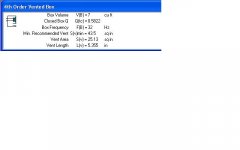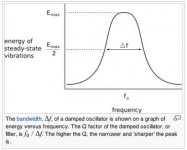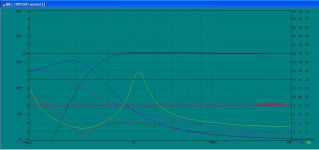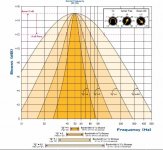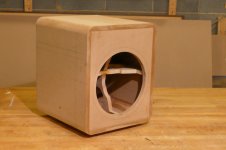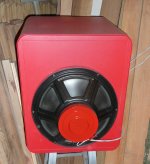OK.... thanks for the lesson about Q.
Also, I am delighted to learn that is not beyond human ingenuity to separate one source of sound power from another such as by assessing port output in isolation. Never the less, as I said, the total output curve (so prettily drawn by the simulation program) does not tell you whether BR sound is coming from the speaker or resonating out the port and interacting (in a complex temporal and spatial way that can be quite screwy in your living room*) with each other's outputs.
But back to resonant boxes.
With BR, you are introducing and trafficking in resonances, even when they are kind of damped enough not to ring (but also not so puny they don't make that audible bump on the simulation curves... which might be quite audible). Can't have it both ways or rather, can't have it one way without the other.
Ben
*And that's without even mentioning the acoustically disgusting conditions that take place below the box resonance range.
I like this: "you are introducing and trafficking in resonances"
interesting logic flaw. no insult intended. good words. graphic. you make it seem like there are none of these looming "resonances" without a port. the room you are sitting in has resonances. The cavities in the walls have resonances, the materials the house is built of have resonances. the chair you are sitting on has resonances, the speaker box has...
boo!
hehe
Now, with a BR system you are introducing more variations than a sealed system but we are talking about very small additions and if designed properly are minimized so you have a favorable compromise.
let's not get into reflections and nulls, oh my...
I cant rely on numbers. I have no problem building 3-4 boxes and testing them all in my room
Absolutely, every speaker i've ever built has been modified after initial construction. Mostly to account for materials variations, unexpected environmental concerns, temps, etc.
Stuffing and bracing a sealed box is always an experimental process.
I find the more I've used a simulator the better I am at noting it's flaws/limitations and adjusting while designing.
so yes, simulations are only the beginning.
Naturally. I would never quibble with a definitive pronouncement from a
recognized authority such as yourself. But would it be too much trouble
to explain what you happen to be talking about for us little people?
Ben
Hi,
The problem is you are making statements that are not essentially true.
It is not that I need to explain what I'm talking about, it is that you
should not make statements without knowing what your talking about.
Vented boxes do not have inevitable colouration due to "resonance".
That is simply a dogmatic opinion that has no basis in practical reality.
For sure, I could build a vented "boombox" that sounds exactly like
its moniker, but I can also build vented boxes with the right driver
and design decisions for the room and speaker placement that do
work exceptionally well, with none of the alleged dogmatic issues.
Horses for courses, sealed with some drivers, vented with others,
if you want sealed, use the right driver for the application. If you
want the highest bass SPL for a given driver suitable for vented,
then that is the only way to go, max SPL of a vented 6.5" driver
is equivalent to that of a 13" sealed driver at Fvent.
Anyone who understands low bass knows its SPL that matters.
Vented alignments can be arranged for a quasi 6dB/octave roll-off.
Done this way, with low vent tuning and positioned to utilise room
gain at low frequencies, the results can be eye opening. There is no
downside with proper design decisions, it works as well as it can.
However to do the above you need a carefully chosen bass driver.
rgds, sreten.
Last edited:
I should say, I'd like to get a port to have a Q of .5 but still figuring that one out. getting close though.
The software I use has a "closed box Q" in the data for the 4th order vented box alignment. Is this same thing that you are talking about? I find that a Q of around 0.5 seems to give the best response curve.
Attachments
Hi,
The problem is you are making statements that are not essentially true.
It is not that I need to explain what I'm talking about, it is that you
should not make statements without knowing what your talking about.
rgds, sreten.
Jeez man, the guy asks for help and you just basically tell him he's an idiot. I think that most of us are here to learn something, even if what we think we know is wrong we don't need to have our noses rubbed in it. It would be far better to refer him to a book or a website where he can learn some more about this particular issue than to just lambaste him for making a statement that he thought was true. I'm sure you've said something that you thought was absolutely true at some point in your life and then were proven wrong.
The software I use has a "closed box Q" in the data for the 4th order vented box alignment. Is this same thing that you are talking about? I find that a Q of around 0.5 seems to give the best response curve.
It gets complex but basically when you look at the port output/gain the flatter the "mountain" the lower the Q... a picture would help.
wiki to the rescue.
Attachments
Last edited:
It gets complex but basically when you look at the port output/gain the flatter the "mountain" the lower the Q... a picture would help.
wiki to the rescue.
The software I have doesn't show just the port response unfortunately, or at least, I have not figured out how to display it. I pretty much understood the concept of Q when it comes to resonance but thanks for the re-enforcement.
Attachments
In EQ terms, the Q is how wide or narrow the band is... same principle right?
I'm an ME, not and EE, so I would say that you are correct though of course I could be wrong.
Jeez man, the guy asks for help and you just basically tell him he's an idiot.
I think that most of us are here to learn something, even if what we think
we know is wrong we don't need to have our noses rubbed in it. It would be
far better to refer him to a book or a website where he can learn some more
about this particular issue than to just lambaste him for making a statement
that he thought was true. I'm sure you've said something that you thought
was absolutely true at some point in your life and then were proven wrong.
Hi,
No. In this case said person was just expounding their own opinion,
not helping anybody, not asking any sensible question, or for any
help, just basically stating that vented is always wrong, it isn't.
My first reply got a condescending reply, hence the tone of the 2nd reply.
Having said that, the issue is also completely off topic in this thread,
and I should have ignored the post I replied to, such is hindsight.
rgds, sreten.
Hi,
A closed box Q of 0.5 means the situation is eminently suitable for venting,
its not the only way of doing it, but generally such a box would be vented.
However as the driver in question has a Qts of 0.44 and it can only increase
in boxes a 0.5 alignment would require a pointlessly huge box, its just wrong.
Any software trying to use such a vented alignment will return a huge box.
Whatever, here around 1 cuft sealed will do what is asked. For vented
~ double box volume and tune very low, but here it seems its not wanted.
rgds, sreten.
Q for a 2nd order bandpass is related to peak height and width, the higher
the former, the lower the latter. For 2nd order highpass (sealed box rolloff)
its not so simple, but practical Q values are ~ 0.5 best transient response,
~ 0.6 best delay response, ~ 0.7 best maximally flat response, 0.8, 0.9, 1.0
and 1.1 have increasing minor peaking before roll-off, increasingly boomy,
though they are all workable in combination with baffle step compensation.
A closed box Q of 0.5 means the situation is eminently suitable for venting,
its not the only way of doing it, but generally such a box would be vented.
However as the driver in question has a Qts of 0.44 and it can only increase
in boxes a 0.5 alignment would require a pointlessly huge box, its just wrong.
Any software trying to use such a vented alignment will return a huge box.
Whatever, here around 1 cuft sealed will do what is asked. For vented
~ double box volume and tune very low, but here it seems its not wanted.
rgds, sreten.
Q for a 2nd order bandpass is related to peak height and width, the higher
the former, the lower the latter. For 2nd order highpass (sealed box rolloff)
its not so simple, but practical Q values are ~ 0.5 best transient response,
~ 0.6 best delay response, ~ 0.7 best maximally flat response, 0.8, 0.9, 1.0
and 1.1 have increasing minor peaking before roll-off, increasingly boomy,
though they are all workable in combination with baffle step compensation.
Last edited:
In EQ terms, the Q is how wide or narrow the band is... same principle right?
In EQ terms Q = qualizer
In sound engineer terms, damped oscillator Q = center frequency / bandwidth at -3db below center frequency.
In EQ terms Q = qualizer
In sound engineer terms, damped oscillator Q = center frequency / bandwidth at -3db below center frequency.
I'm just going by the Q knob on a good EQ (each band has one)... it will either narrow a band to do more notching or widen to lift or decrease a band along with others around it. Adjustable.
Last edited:
Did you build your box yet?
Nosuchpro,
Did you build your box yet? I thought about your project when I worked on this 12” sub box yesterday; also used the large roundover bit I mentioned.
This is 1.8 cf, I’m estimating .25cf for blocking, etc.
Dimensions Inside: 13.5” wide 16.3” tall 14.3” deep.
So far, one day on this, going to sand it up to today. I could build a similar, custom box for say......$100, materials included (3/4” MDF). That quote doesn’t include any sealing/painting, however, it would be size you specify. Also, this is a no nail/screw box; extra glue and clamped (only).
Let me know if you’re interested?
Nosuchpro,
Did you build your box yet? I thought about your project when I worked on this 12” sub box yesterday; also used the large roundover bit I mentioned.
This is 1.8 cf, I’m estimating .25cf for blocking, etc.
Dimensions Inside: 13.5” wide 16.3” tall 14.3” deep.
So far, one day on this, going to sand it up to today. I could build a similar, custom box for say......$100, materials included (3/4” MDF). That quote doesn’t include any sealing/painting, however, it would be size you specify. Also, this is a no nail/screw box; extra glue and clamped (only).
Let me know if you’re interested?
Attachments
Last edited:
Nosuchpro,
Did you build your box yet? I thought about your project when I worked on this 12” sub box yesterday; also used the large roundover bit I mentioned.
This is 1.8 cf, I’m estimating .25cf for blocking, etc.
Dimensions Inside: 13.5” wide 16.3” tall 14.3” deep.
So far, one day on this, going to sand it up to today. I could build a similar, custom box for say......$100, materials included (3/4” MDF). That quote doesn’t include any sealing/painting, however, it would be size you specify. Also, this is a no nail/screw box; extra glue and clamped (only).
Let me know if you’re interested?
Looks good man.... Nice bracing. Yeah I just put together a box... it's not visible so what it looks like doesn't matter. The one you just built would be too big for me, I cant do anymore than 12" high.
I just had to see what I was missing so finished this isobaric sealed box today.
Okay it “works”, I see why folks like the sealed box bass, it hits hard; harder than the array of bass reflex speakers I have on hand. It would sound fantastic outside.
I’m not going to give up my Bass Reflex subs in the home theater just yet though.
The bass hit hard, some overhang in the mid bass; I can’t seem to remove it with the crossover. 200watts on each woofer 8ohm; crossover set @ 40hz sound the best.
I filled the box with small pieces of foam and damping wool, it’s pretty full. Any ideas to smooth out the middle peak would be very helpful :-/
The woofers are over 20 years old, they been sitting around for last 10 years Peerless 831857 ~ 12".
Okay it “works”, I see why folks like the sealed box bass, it hits hard; harder than the array of bass reflex speakers I have on hand. It would sound fantastic outside.
I’m not going to give up my Bass Reflex subs in the home theater just yet though.
The bass hit hard, some overhang in the mid bass; I can’t seem to remove it with the crossover. 200watts on each woofer 8ohm; crossover set @ 40hz sound the best.
I filled the box with small pieces of foam and damping wool, it’s pretty full. Any ideas to smooth out the middle peak would be very helpful :-/
The woofers are over 20 years old, they been sitting around for last 10 years Peerless 831857 ~ 12".
Attachments
Perhaps if you had less confidence in your golden ears and just did a mic freq run with free software such as REV, you'd know what your freq response looked like. Then you can start fixing things. I believe that the great majority of subtle differences heard among cables, tubes, speaker "speed", or whatever are just frequency response effects.
Yes, sealed boxes are nice. I don't know if I've heard too many BRs that I liked much (except some JBLs long ago). Tastes, rooms, sources, etc vary.
Ben
Yes, sealed boxes are nice. I don't know if I've heard too many BRs that I liked much (except some JBLs long ago). Tastes, rooms, sources, etc vary.
Ben
- Status
- This old topic is closed. If you want to reopen this topic, contact a moderator using the "Report Post" button.
- Home
- Loudspeakers
- Subwoofers
- Musical Subwoofer.... ported or sealed?
